Accordion Lessons in Houston, TX
Have you always wanted to learn to play accordion? Dr. Berlin teaches accordion lessons in Houston, Texas blending the ideals of Dr. Shinichi Suzuki's teaching techniques with Dr. Willard Palmer's expertly-edited, high-quality accordion repertoire. For diatonic instruments, Dr. Berlin utilizes Dr. Helmi Harrington's pioneering diatonic accordion methods.
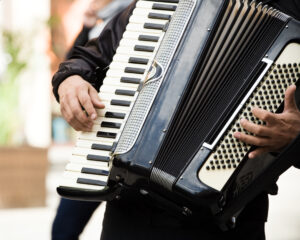
While there is no formally-accredited Suzuki Accordion program in the world, Dr. Suzuki and Dr. Palmer were followers of each other's work and upon meeting for the first time remarked with mutual admiration and respect how influential they had been to each other. The Palmer-Hughes features 10 Accordion Course Books, 5 Recital Books, and 3 Note Spellers make up the core repertoire of the Palmer-Hughes method. Dr. Harrington's methods contain similar material specially selected and arranged for diatonic accordions.
Many Types of Accordions
There are many different types of accordions in existence today. Dr. Berlin is glad to help you choose which accordion is best suited to your musical goals. Accordions can generally be divided into two broad categories: chromatic accordions and diatonic accordions. The chromatic accordion family includes the piano accordion, the C-system chromatic button accordion, and the Bayan or B-system chromatic button accordion.
Chromatic Accordions
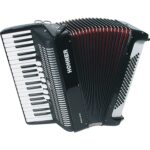 Piano Accordion Most popular in the USA and easiest to learn. |
 C-System Chromatic Popular in Western Europe and gaining popularity in the USA and Canada. Notice: Row 3 has three white buttons in a line. |
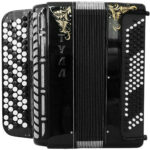 Bayan or B-System Chromatic Popular in Eastern Europe and Russia. Notice: Rows 1 and 4 have three white buttons in a line. |
Important: Chromatic button accordions come in 3-, 4-, and 5-row models. Dr. Berlin urges chromatic button accordion students to begin on 5-row models.
Diatonic Accordions
Button diatonic accordions are generally lighter and more compact than chromatic accordions. These accordions are are among the most popular instruments in the world. Their basic do-re-mi-fa-so-la-ti-do organization is easy to understand, pleasant to learn, and appropriate to the playing of most popular folk music. Popular diatonic accordion models are the three-row "Bohemian" accordion and the single row melodeon, also known locally as the Cajun accordion.
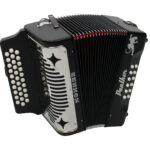 Three-Row "Bohemian" Popular in the Southern USA and Central and South America. |
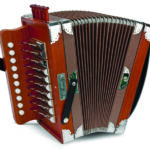 One-Row Melodeon Popular in Southwest Louisiana and Southeastern Texas. |
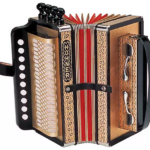 One-Row Melodeon Popular in Southwest Louisiana and Southeastern Texas. |
Important: Diatonic accordions come in various keys. Dr. Berlin teaches one-row accordion in the key of C and three-row accordion in the G-C-F configuration.
Some types of accordions are definitely easier to learn and applicable to more styles of music than others. Dr. Berlin will be glad to help you decide what accordion is best for you!
When to Begin?
Because Suzuki music instruction is linguistic in nature, it has been found that students can begin learning this second, musical language shortly after they have begun acquisition of their first, spoken language. Most students can begin learning an instrument as early as age three or four. Young students interested in the accordion begin on melodicas (mouth-blown keyboard instruments) and transition to the accordion at age seven or eight. Young students interested in the piano or organ can also begin on a melodica. Learning the accordion supports learning of both the piano and the organ. In fact, students can even learn two instruments at once!
Dr. Berlin Has Taught Accordion to More Than 1,000 Students!
To the parent of a young child interested in the accordion, I suggest you start them as early as possible. This will ensure that accordion playing becomes a part of their daily routine from which they will not deviate with competing activities vie for their time later in adolescence. To the older student, I suggest you start as soon as possible. It is never too late to begin!
Misconceptions
Because of the many remarkable videos available of very young Suzuki students performing advanced repertoire, some people mistakenly believe that Suzuki is a "children's method" not suitable for later beginners or adults. This is certainly not the case. Any person, at any age, with an interest in learning an instrument can thrive under the guidance of a certified Suzuki teacher.
Another misconception is that students are taught by rote and that music reading is not emphasized. This is also not the case. It is for the pre-literate student that written music is not emphasized. As the student begins to become a literate person in their primary language (e.g. English), they are introduced to reading in a very natural, developmentally-appropriate fashion.
Students are trained to play by ear, not by rote. The difference may seem subtle to the casual readers, but it is substantial. Listening and mimicking is a natural process of language acquisition. Ear training is also used for older, literate students.
Principles of Study and Guidance
- The student should listen to reference recordings every day... to develop musical sensitivity. Rapid progress depends on this listening.
- Tonalization, or the production of beautiful tone, should be stressed in the lesson and at home.
- Constant attention should be given to correct posture and proper hand positioning.
- Parents and teachers should strive to motivate the [student] so [they] will enjoy practicing correctly at home.
(excerpted from Suzuki Guitar School, Vol. 1. Van Nuys, CA: Alfred Music, 2018, 4.)
The adult or self-motivated adolescent student will naturally not require the same level of external motivation as younger students. Nevertheless, others in the home should support and encourage the music student's endeavors.
Preparation for College
and Beyond!
For the advanced student, the Palmer-Hughes repertoire includes material suitable for the college and professional level. A student beginning at age three or four with a support system in place who practices regularly can expect to complete the final book in high school. When the students are ready to apply for college, their life-long dedication will cause them to stand out and be noticed for acceptance and scholarship. Even if the student does not study music in college, they will be equipped and primed for a life-long relationship with music through their accordion which will never leave them.
The Berlin Accordion Method
The only person that really taught "The Suzuki Method" was Dr. Suzuki. There is no "one, true way" to teach an instrument. Every student is different and every teacher has their own unique and innovative strengths and strategies for their students. Dr. Berlin's background, personal study, and scholarship makes his teaching unique in all the world, even with a shared repertoire!
Graded Supplemental Repertoire
A high-quality graded teaching repertoire is essential to student success. The core Palmer-Hughes repertoire is listed to the right. These are the central pieces for those studying the three types of chromatic accordions. Additionally, the graded "Recital" series is intended to accompany the P-H tutor books 1-5 and theory books. Students working through the material have a expansive range of repertoire from which to draw.
O, Dear, What Can the Matter Be? * Cuckoo Waltz * Pop! Goes the Weasel * Beautiful Brown Eyes * The Grey Goose * Aura Lee * A Tisket, A Tasket * I Wish I Were Single Again * Our Boys * The Monkey and the Owl * Bugs * Waltz (from Poet and Peasant) - Suppe * Barcarolle (from Tales of Hoffman) - J. Offenbach * Shortnin' Bread * Home, Sweet, Home - Bishop * Starlight Waltz * Largo (Dvorak) * Ideal March * Tourelay * Nobody Knows the Trouble I've Seen * My Wild Irish Rose * Ta-ra-ra-boom-de-ay * Invitation to the Dance * Home on the Range * Nelly Bly * Liebestraum * The Fortune Teller * Gay Nineties * Patriotic Medley * Jenny Lind Polka - A. Wallerstein * La Golondrina (The Swallow) - Serpadell * Soldier's Joy * Skater's Waltz - Waldteufel * Waiting for the Robert E. Lee - Muir-Gilbert * Just a Song at Twilight (Love's Old Sweet Song) - J.L. Molloy * Barbara Polka * Gold and Silver - Franz Lehar * Battle Hymn of the Republic - Bishop * Oh Where, Oh Where * American Patrol - F.W. Meacham * Bella Bocca Polka * Billboard March * British Grenadiers * Gypsy Dance * Hawaiian War Dance * La Raspa * Melody of Love * P-H Polka * Wedding of the Winds * Popcorn Polka * Can-Can * Grand Old Medley * Serenade for Strings * Spinning Song * National Emblem * Mystery Theme * Ballet Music from "Faust" * Banderas
...and MORE!
In addition to the music in the lesson and recital books, there are many other high-quality repertoire collections. The 71 books expertly written and edited by Palmer and Hughes provide accordionists a lifetime of material to enjoy!
Harrington Triple-Row "Bohemian" Teaching Repertoire
Take Off * First Waltz * Pop! Goes the Weasel * Au Clair De la Lune * Oh Dear, What Can the Matter Be? * Little Hans * Flying * Twinkle, Twinkle Little Star * Going Higher * Beautiful Brown Eyes * Sleep, Holy Child, Sleep * Skip to My Lou * Mary Had a Little Lamb * Wooden Heart * Old MacDonald * Camptown Races * L-P Treble * L-P Waltz * L-P March * Going Home * Kumbaya * Home Sweet Home * London Bridge * A Cute Tune * Give Back My Heart * Starlight Waltz * Five Higher * L-P Five Higher * I Saw Three Ships * Red River Valley * Big Parade * When the Saints Go Marching In * Marines' Hymn * Oh! Suzanna * Down in the Valley * Schnitzelbank * Singing Basses * Another Little Hans * Aura Lee * Give Back My Heart * Du, Du Liegst Mir Im Herzen * Ode to Joy * Tom-Tom Song * Little Exercise * Make the Difference * Cockles and Mussels and more!!!
Once students master these core teaching tunes, they then have the musical and technical foundation to pursue other types of music including Cajun, Conjunto, Creole, Norteño, Tejano, and Zydeco!
Harrington Single-Row Accordion / Melodeon Teaching Repertoire
Take Off * First Waltz * Second Waltz * Au Clair De la Lune * Little Hans * Oh Dear, What Can the Matter Be? * Mary Had a Little Lamb * Sleep, Baby, Sleep * Twinkle, Twinkle Little Star * London Bridge * Wooden Heart * Home Sweet Home * Kumbaya * Joy to the World * Camptown Races * Bye, Bye, My Baby * Going Home * Give Back My Heart * Soldier's Joy * Cuckoo Waltz * Chicken Dance * Echoes * Johann pa Snippen * Brahms' Lullaby * America * Morning Has Broken * Silent Night * Cajun Lullaby * Frosty the Snowman * Life in the Finnish Woods * Du, Du, Liegst Mir Im Herzen * Snow Waltz.
Once students master these core teaching tunes, they then have the musical and technical foundation to pursue other types of music including Cajun, Creole, and Zydeco!
Culturally Responsive Repertoire
Please see Dr. Berlin's page on culturally responsive repertoire.
Palmer-Hughes Repertoire
- Skating
- Go 'Way
- Merrily We Play Along
- Horse Sense
- The Donkey
- Jingle Bells
- All Through the Night
- Join the Fun
- Dreaming
- Indian Song
- My Bonnie
- There's No Place Like Home
- Old MacDonald
- The Can-Can
- Vegetables on Parade
- Drink to Me Only With Thine Eyes
- Camptown Races
- The Caissons Go Rolling Along
- Come to the Sea (Vieni Sul Mar)
- Marine's Hymn
- Echo Waltz (adapted) - Franz Behr
- Vive L'Amour
- She'll Be Comin' 'Round the Mountain
- Over The Waves
- Golden Slippers - J.A. Bland
- Chiapanecas
- Country Gardens
- Minka
- The Merry Widow (waltz) - Franz Lehar
- La Donna E Mobile - G. Verdi
- County Fair (Varsouviana)
- Arabian Enchantment (Scheherazade) - Rimsky-Korsakoff
- Arkansas Traveller
- Danube Waves - S. Ivanovici
- William Tell - Rossini
- Riding on the Range
- Little Brown Jug Polka
- Cielito Lindo - C. Fernandez
- Oh, Susanna! - S. Foster
- Alouette (bass)
- Song of the Volga Boatmen
- Zacatecas - Codinas
- Emperor Waltz - Johann Strauss
- Fascination
- Santa Lucia
- Mexican Hat Dance (Jarabe Tapatio)
- Second Hungarian Rhapsody - Franz List
- A-Hunting We Will Go!
- The Star Spangled Banner
- Light Cavalry - Suppe
- Tell Me Your Dreams - Daniels
- Cotton-Eyed Joe
- Ciribiribin - A. Pestalozza
- Scotland the Brave
- The Thunderer - Sousa
- Comedians' Dance - G. Kabalevsky
- La Cucaracha
- The Glow Worm - Paul Lincke
- Ragtime Cowboy Joe - Muir, Abrahams, Clarke
- Blow the Man Down (bass)
- Sharpshooters March - G. Metallo
- Treasure Waltz (from Gypsy Baron) - Strauss
- Clarinet Polka
- Two Guitars
- Prelude in A Major - F. Chopin
- La Spagnola - V. Di Chiara
- Roumanian Rhapsody No. 1 - G. Enesco
- Repasz Band - H.J. Lincoln
- Degoza - Nazareth
- Drink! Drink!
- Parade of the Tin Soldiers - Jessel
- Silver Skates (adapt. fr Louin du Bal)
- Our Director - E. Bigelow
- Waltz Theme - A. Durand
- Hungarian Dance No. 1 - Johannes Brahms
- El Relicario - J. Padilla
- Semper Fidelis - John Philip Sousa
- Charlie the Boxer - Stanley Karankowski
- Come Back to Sorrento (Torna a Surriento) - E. De Curtis
- La Cumparsita - C.M. Rodriguez
- Turkish Rondo - Mozart
- Hungarian Dance No. 5 - Johannes Brahms
- Entry of the Gladiators - J. Fucik
- Roses from the South - Johann Strauss
- Espana - Waldteufel
- Funiculi Funicula - L. Denza
- Toccata in D Minor - J. S. Bach
- Washington Post - John Philip Sousa
- Laughing Polka
- Medley of Strauss Waltzes
- Saber Dance - Khachaturian
- Dark Eyes
- Russian Sailors' Dance - R. Gliere
- Juarez (based on Jaleo de Jerez)
- Neapolitan Song (Swan Lake Ballet) - Tschaikowsky
- Canzone Amorosa (from A Day in Venice) - Ethelbert Nevin
- Stars and Stripes Forever - Sousa
- La Cinquantaine (Golden Wedding) - Gabriel, Marie
- El Choclo
- Czardas - V. Monti
- La Virgen de la Macarenas
- March of the Toys (fr Babes in Toyland) - Victor Herbert
- Waltz in Db Major (Minute Waltz) - Frederic Chopin
- Hungarian Dance No. 6 - Johannes Brahms
- One Fine Day (Un Bel Di, Vedremo from Madame Butterfly)
- Flight of the Bumblebee - Rimsky-Korsakov
- The Young Prince and the Young Princess (Scheherazade) - Rimsky-Korsakov
- Variations on a Ukrainian Theme (Schone Minka)